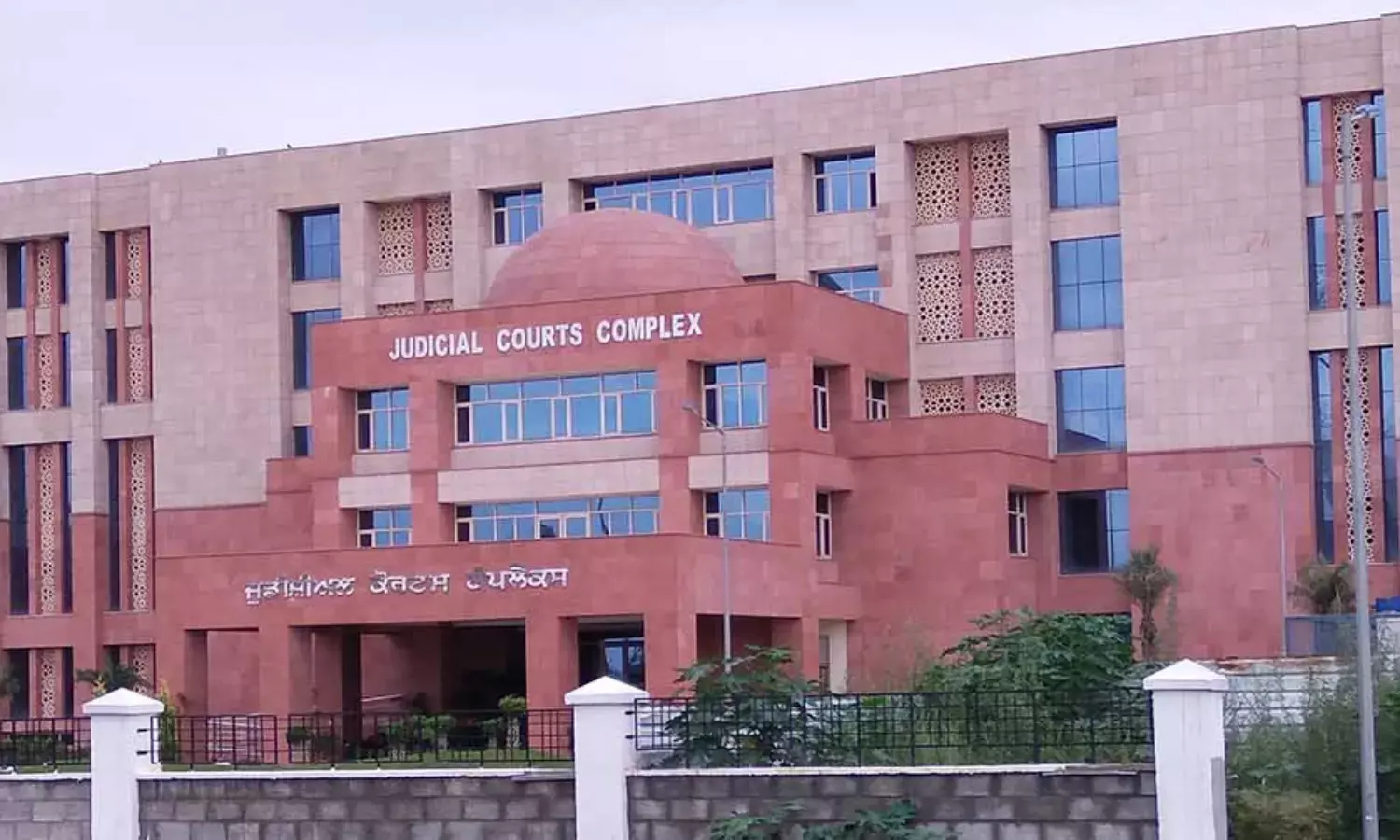டெல்லி, சண்டிகர் மாவட்ட நீதிமன்றங்கள் மட்டுமே 2012 உள்கட்டமைப்பு வழிகாட்டுதல்களை நிறைவேற்றுகின்றன: அறிக்கை

மும்பை: இந்தியாவில் உள்ள அனைத்து மாநிலங்கள் மற்றும் யூனியன் பிரதேசங்களில், டெல்லி மற்றும் சண்டிகரில் உள்ள மாவட்ட நீதிமன்றங்கள் மட்டுமே 2012 இல் தேசிய நீதிமன்ற மேலாண்மை அமைப்புகள் (என்.சி.எம்.எஸ்) குழு வகுத்த உள்கட்டமைப்பு வழிகாட்டுதல்களை நிறைவேற்றுகின்றன என்று, சிந்தனை அமைப்பான் விதி சட்டக் கொள்கைக்கான புதிய அறிக்கையில் தெரிவிக்கப்பட்டுள்ளது.
பிற மாவட்ட நீதிமன்றங்களில் பெரும்பாலானவை மாற்றுத்திறனாளிகள் எளிதில் அணுக முடியாதவை; அவற்றில் 60% முழுமையான செயல்பாட்டுடன் கழிப்பறை இல்லை என்று தகவல்கள் தெரிவிக்கின்றன.
ஒவ்வொரு மாவட்ட நீதிமன்றமும் ஒன்பது அளவுருக்கள்- அதாவது அங்கு செல்வது, வழிப்பாதை , காத்திருக்கும் பகுதிகள், சுகாதாரம், தடை இல்லாத அணுகல், வழக்கு காட்சி, வசதிகள், பாதுகாப்பு மற்றும் நீதிமன்ற வலைத்தளம் - என்ற அடிப்படையில் மதிப்பிடப்பட்டது.
இக்கணக்கெடுப்பில் சண்டிகர் (100%) மற்றும் டெல்லி (90%) என்ற நல்ல நிலையில் இருந்தாலும், பீகார் (26%), மணிப்பூர் (29%), நாகாலாந்து (29%) ஆகியவை மிக மோசமான சூழலில் உள்ளன. 29 மாநிலங்கள் மற்றும் ஏழு யூனியன் பிரதேசங்களில், ஐந்து மாநிலங்கள் மற்றும் நான்கு யூனியன் பிரதேசங்கள் மட்டுமே 60 க்கு மேல் மதிப்பெண் பெற முடிந்தது (அரசியல் சாசனம் 370ஆவது பிரிவில் மாற்றத்திற்கு பிறகு, ஆகஸ்ட் 6, 2019க்கு பின்னர் மாநிலங்களின் எண்ணிக்கை 28 ஆகவும், யூனியன் பிரதேசங்கள் ஒன்பது ஆகவும் அதிகரித்துள்ளது. ஜம்மு-காஷ்மீர் இனி ஒரு மாநிலமாக இல்லை, அது ஒரு யூனியன் பிரதேசமாக இருக்கிறது. லடாக் இப்போது ஒரு யூனியன் பிரதேசம் ஆகும்).
Source: Building Better Courts, a report by Vidhi Centre for Legal Policy
கடந்த 2012 என்.சி.எம்.எஸ் வழிகாட்டுதல்கள் நீதிமன்ற உள்கட்டமைப்பிற்கான விரிவான திட்டத்தை வகுத்துள்ளன. "நிலுவை பங்களிக்கும் மிக முக்கியமான காரணிகளில் ஒன்று, போதுமான எண்ணிக்கையிலான நீதிபதிகள் இல்லாதது மற்றும் தேவையான உள்கட்டமைப்பு" என்று வழிகாட்டுதல்களின் அறிமுகம் கூறியது.
மாவட்ட மற்றும் பிற துணை நீதிமன்றங்களில் நிலுவையில் உள்ள 258,965 வழக்குகள், நாட்டின் மொத்த நிலுவையில் உள்ள வழக்குகளில் 64.37% ஆகும் என்று சட்டம் மற்றும் நீதி அமைச்சர், 2019 ஜூலை 19 அன்று மக்களவையில் பதில் அளித்தார்.
கீழமை நீதித்துறை என்பது பெரும்பாலான வழக்குரைஞர்களுக்கான தொடர்புகளின் முதல் புள்ளியாகும். மேலும் இந்தியா முழுவதும் 665 மாவட்ட நீதிமன்றங்களை மதிப்பிடுவது, 6,650 வழக்குரைஞர்களை நேர்காணல் செய்வதன் மூலம் வழக்குரைஞர்களின் பார்வையில் இருந்து, அதற்கான அணுகலை ஆய்வு செய்தது.
மாற்றுத்திறனாளிகளுக்கான அணுகல்
மூத்த குடிமக்கள் மற்றும் மாற்றுத்திறனாளிகள், நீதிமன்றங்களை எளிதாக அணுக முடியுமா என்பதை அறிய, கணக்கெடுப்பு மூன்று அடிப்படை அம்சங்களை - சாய்தளம் மற்றும் லிஃப்ட் அல்லது எஸ்கலேட்டர், காட்சிப்பட உதவி குறியீடு மற்றும் மாற்றுத்திறனாளிகளுக்கான கழிப்பறை - ஆகியவற்றை ஆராய்ந்தது. இதில், 2% நீதிமன்றங்களில் மட்டுமே காட்சிப்பட உதவி குறியீடுகள் இருந்தன; 11% நீதிமன்றங்களில் கழிப்பறை, 27% கட்டடங்களில் சாய்தளம் மற்றும் லிப்ட் அல்லது எஸ்கலேட்டர் வசதி இருந்தது.
மாற்றுத்திறனாளிகள் பெரும்பாலான மாவட்ட நீதிமன்றங்கள் அணுக முடியாது

Source: Building Better Courts
இந்த மூன்று அம்சங்கL அடிப்படையில் சண்டிகரில் உள்ள மாவட்ட நீதிமன்றம் மட்டுமே தேர்ச்சி பெற்றிருந்தது. மற்ற மாநிலங்கள் எதுவும் 50% மதிப்பெண்ணை கூட் பெற முடியவில்லை. மொத்தம் 100 புள்ளிகளில், யூனியன் பிரதேசங்களான லட்சத்தீவு மற்றும் டெல்லி முறையே 67 மற்றும் 55 புள்ளிகளைப் பெற்றன.
சுகாதாரம்
665 நீதிமன்றங்களில் 585 (88%) ஒரு கழிப்பறை வசதி இருந்தது; அதில், 40% மட்டுமே முழுமையாக செயல்பட்டன. ஒரு முழுமையான கழிப்பறை என்பது, தண்ணீர் வசதி, சுத்தம் செய்தல் ஆகியவற்றை கொண்டு வரையறுக்கப்பட்டது. இது வழக்கமாக சுத்தம் செய்வதற்கான ஏற்பாடு மற்றும் பாலினத்தால் பிரிக்கப்பட்டுள்ளது. கோவா நீதிமன்றங்களின் எந்தவொரு கழிப்பறையிலும் தண்ணீர் செல்லவில்லை அல்லது தொடர்ந்து சுத்தம் செய்யப்படவில்லை. இது சுகாதாரத்திற்கான மிகக் குறைந்த தரத்தை அளிக்கிறது.
| 60% District Courts Do Not Have Fully Functioning Washrooms | |
|---|---|
| Washrooms Present | 88 |
| Male and Female Washrooms Present | 85 |
| Fully Functioning Washroom | 40 |
Source: Building Better Courts
மேலும், 15% நீதிமன்றங்களில் பெண்களுக்கு தனி வாஷ்ரூம்- கழிப்பறை இல்லை. ஆந்திரா (69%), ஒடிசா (60%) மற்றும் அசாம் (59%) ஆகியவற்றில் பாதிக்கும் மேற்பட்ட மாவட்ட நீதிமன்றங்களில் பெண்களுக்கு தனித்தனி கழிப்பறை இல்லை.
கழிப்பறை தரத்தை எவ்வாறு மேம்படுத்த வேண்டும் என்று கேட்டபோது, வழக்குரைஞர்கள் தண்ணீர் மற்றும் தண்ணீர் பீய்ச்சியடிக்கும் வசதியை கொண்டு அதன் அவசியத்தை வலியுறுத்தினர்.
பாதுகாப்பு
இந்தியாவில் உள்ள 89% மாவட்ட நீதிமன்றங்களில் பொருட்களை ஸ்கேனிங் செய்யும் வசதி இல்லை; 71% கட்டடங்களில் தீ அணைப்பான் கருவிகள் உள்ளன; 52% கட்டிடங்களில் அவசரகால வெளியேறும் வசதிகள் இல்லை.
ஸ்கேனிங் வசதி இல்லாத 89%மாவட்ட நீதிமன்றங்கள்

Source: Building Better Courts
வசதிகள்
கிட்டத்தட்ட பாதி எண்ணிக்கை (46%) மாவட்ட நீதிமன்றங்களில் காத்திருப்பு அறை இல்லை. ராஜஸ்தான் (14%) மற்றும் பீகார் (16%) ஆகியன, காத்திருப்பு அறை வசதி கொண்ட நீதிமன்றங்களின் மிகக் குறைந்த சதவீதத்தை கொண்டு இருந்தன. மறுபுறம், டெல்லி, குஜராத், கோவா, இமாச்சலப் பிரதேசம் மற்றும் மேகாலயா ஆகியவற்றில் அனைத்து மாவட்ட நீதிமன்ற வளாகங்களிலும் காத்திருப்பு அறைகள் இருந்தன.
காத்திருப்பு அறைகளில் சிறந்த வசதி என வழக்குரைஞர்கள் கூறிய முக்கிய அம்சங்கள்: அதிக இருக்கைகள் (69%), சிறந்த காற்றோட்டம் (37%) மற்றும் அதிக அளவு தூய்மை (26%).
பெரும்பாலான நீதிமன்றங்களில் தட்டச்சர்கள் (100%), நகல் எடுப்பவர்கள் (98%), முத்திரை விற்பனையாளர்கள் (97%) மற்றும் பொது நோட்டரிகள் (96%) இருந்தனர். ஆனால் முதலுதவி சிகிச்சை வசதி 59% நீதிமன்றங்களில் மட்டுமே காணப்பட்டது.
செல்வதற்கான வழிகாட்டுதல் வசதி
மதிப்பீடு செய்யப்பட்ட பெரும்பாலான நீதிமன்றங்களில் (80%), அங்கு செல்வதற்கான பொது போக்குவரத்து வழிகாட்டுதலை அணுகும் வசதி மற்றும் பார்க்கிங் இடம் (81%) இருந்தன. இதில் ஆந்திரா, கோவா மற்றும் கேரளா ஆகியன உயர்ந்த இடத்தையும்; குஜராத், சிக்கிம், திரிபுராவில் உள்ள மாவட்ட நீதிமன்றங்கள் அணுகல் வசதி மிகக் குறைந்தும் காணப்பட்டன.
நீதிமன்றங்களில் 20% மட்டுமே வழிகாட்டி வரைபடங்கள் மற்றும் 45%இல் மட்டுமே உதவி செய்யக்கூடிய மேசைகள் இருந்தன. பெரும்பாலானவர்கள் (59%) நீதிமன்ற வளாகத்திற்குள், வழக்குரைஞர்களிடம் வழி கேட்டனர்.
(ஸ்ரேயா ராமன், இந்தியா ஸ்பெண்ட் தரவு ஆய்வாளர்).
உங்களின் கருத்துகளை வரவேற்கிறோம். கருத்துகளை respond@indiaspend.org. என்ற முகவரிக்கு அனுப்பலாம். மொழி, இலக்கணம் கருதி அவற்றை திருத்தும் உரிமை எங்களுக்கு உண்டு.

